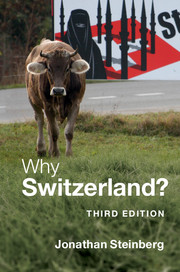2 - History
Published online by Cambridge University Press: 05 November 2015
Summary
Switzerland has no natural frontiers. The mountains and valleys of the Alps continue to the east and west into what is now Austria and France as they do on the southern slopes into what is now Italy. That the Bregaglia and the valley of Poschiavo are Swiss, while the Valtellina or the county of Bormio are Italian, can only be understood historically. Every Swiss frontier represents an historic act or set of events. Vorarlberg is Austrian because the Great Powers in 1919 refused to accept a plebiscite of its people for union with Switzerland. Geneva's borders on Lac Léman were settled by the Vienna Congress. Canton Ticino was conquered by Uri and later by other Swiss cantons. Constance, the ‘natural’ capital of the Thurgau, is German, partly because the Swiss Diet lacked the nerve in 1510 to accept another city-state into the Federation for fear of upsetting the urban–rural balance. Canton Schaffhausen contains one parcel of 41 hectares in its midst which is, in fact, German territory, and has three substantial enclaves, which cannot be reached without passing through German territory. Nor is the picture more coherent within Switzerland. Boundaries between cantons wander irregularly and unexpectedly over the landscape. Bits and pieces of Canton Solothurn lie embedded in Canton Bern, two of which, Kleinlützel and Mariastein, have borders with France as well. In Kleinlützel when people go shopping in one of the neighbouring larger towns, they tend to say ‘we're going up to Switzerland’. Campione d'Italia on the eastern shore of Lago di Lugano is a chip of Italy, precisely 2.1 kilometres long and just over 1 kilometre deep at its widest point. The territory, much of which is actually lake surface, is entirely surrounded by the Swiss Canton Ticino. The complex overlapping of political authority, the jagged nonsense of frontiers and boundaries, the bits and pieces of territory lying about the map, resemble a jigsaw puzzle constructed by a whimsical providence.
Part of the key to the puzzle is what did not happen in Switzerland, rather than what did. The Swiss escaped the full consequences of three characteristic European trends: the trend towards rational centralisation, the growth of nationalism and the violence of religious conflict. Let us look at each in turn.
The French and their fellow travellers tried to make sense of Switzerland in the period between 1798 and 1802.
Information
- Type
- Chapter
- Information
- Why Switzerland? , pp. 8 - 80Publisher: Cambridge University PressPrint publication year: 2015
